|
|
|
Sort Order |
|
|
|
Items / Page
|
|
|
|
|
|
|
| Srl | Item |
| 1 |
ID:
185994


|
|
|
|
|
| Summary/Abstract |
The regime built around the 1970 Treaty on the Non-Proliferation of Nuclear Weapons (NPT) has helped curtail the spread of nuclear arms for fifty years. In hindsight, it is remarkable only nine states possess the world’s most powerful weapon. The NPT achieved much success during Cold War bipolarity and U.S. unipolarity in its aftermath. But today, China’s rise and Russia’s resurgence have ushered in a new era of emerging multipolarity. Can the treaty withstand the potential challenges of this dynamic environment? There is a real risk that multipolarity may shake the scaffolding of the nonproliferation regime, presenting a significant test to the NPT’s durability. This article identifies four essential elements of the nonproliferation regime: widespread membership, adaptability, enforcement, and fairness. History suggests bipolarity and unipolarity in the international system largely sustained and promoted these NPT features. When international regimes lack such elements, it sharply curtails their long-term efficacy.
|
|
|
|
|
|
|
|
|
|
|
|
|
|
|
|
| 2 |
ID:
185999


|
|
|
|
|
| Summary/Abstract |
The nuclear Non-Proliferation Treaty (NPT) constitutes just one component of broader arrangements that provide global nuclear governance. In recent decades, the other props in the global nuclear order beyond its nonproliferation elements have been eroding, thereby putting more weight on the contributions of the NPT and other aspects of the nonproliferation regime. Unfortunately, recent progress in building up the NPT-based nonproliferation regime seems also to have halted. This article outlines the elements of the global nuclear order and identifies signs of erosion in that order. It discusses whether a greater commitment to nuclear disarmament might help counter that erosion and highlights the underlying cognitive dimension of efforts to avoid nuclear war.
|
|
|
|
|
|
|
|
|
|
|
|
|
|
|
|
| 3 |
ID:
185993
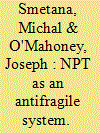

|
|
|
|
|
| Summary/Abstract |
We introduce “antifragility” as a conceptual framework to understand the impact of occasional violations of regime norms on the health of respective regimes. Contrary to the prevailing understanding of norm violation as a strictly negative phenomenon that leaves regimes damaged, we show that normative deviance is, under certain conditions, a stressor that helps predominantly antifragile systems learn, improve, and adapt to changes in both internal and external environments. We apply this conceptual framework to the case of the NPT regime and the prominent violations of its nonproliferation norms by India in the 1970s (as a “contestation from outside”) and Iraq in the 1990s (as a “contestation from within”). Our findings question the prevailing catastrophizing narrative about the strictly negative impact of norm violations on regime stability and contribute to contemporary scholarly debates about norm dynamics within the NPT.
|
|
|
|
|
|
|
|
|
|
|
|
|
|
|
|
| 4 |
ID:
185995
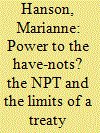

|
|
|
|
|
| Summary/Abstract |
The nuclear Non-Proliferation Treaty (NPT), its evolution over the past five decades, and the dissatisfaction of the non-nuclear states within it, can be analyzed by focusing on different understandings of power. Within the various concepts of power are claims which distinguish between what is known broadly as “power-over” and a more subtle form of influence, “power-to.” This article explores the history of the NPT, showing how the nuclear weapon states have shaped and limited this institution by practices which fall within the relational emphasis of “power-over.” Recently, however, non-nuclear states have adopted a “power-to” approach. Frustrated by their inability to bring about substantive change within the limits of the NPT, these states have realized and applied their agency and collective “power-to” in order to create an alternative approach to the problem of nuclear weapons in the context of the Treaty on the Prohibition of Nuclear Weapons (TPNW).
|
|
|
|
|
|
|
|
|
|
|
|
|
|
|
|
| 5 |
ID:
185996
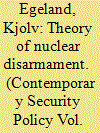

|
|
|
|
|
| Summary/Abstract |
What might prompt a nuclear-armed state to give up its arsenal? Nuclear disarmament has provided a nominally shared goal for virtually all the world’s states for decades, yet surprisingly little effort has been devoted to systematically theorizing its drivers. This article aims to begin filling this void. I proceed in three steps. First, I discuss the conceptual, material, and ideational features of renunciation to arrive at a rudimentary understanding of what, fundamentally, nuclear disarmament as a political process involves. Second, I scope out the empirical evidence on which a general theory of nuclear renunciation might be based. Third, synthesizing the dominant explanations for the cases discussed in the second part, I outline a basic account of nuclear relinquishment and discuss the compatibility of this account with common assumptions about disarmament practice. I conclude that the best evidence available suggests that adversarial politics and stigmatization are necessary conditions for renunciation.
|
|
|
|
|
|
|
|
|
|
|
|
|
|
|
|
| 6 |
ID:
185992


|
|
|
|
|
| Summary/Abstract |
The most inclusive security treaty in the world, the Treaty on the Non-Proliferation of Nuclear Weapons (NPT) turned 50 in 2020. Our special issue takes stock of the NPT’s vitality after these five decades. In this introduction, we emphasize the need to distinguish between the treaty instrument and the larger nuclear nonproliferation regime. Next, we consider a recent development that may represent a serious impending shock which could weaken the NPT: dramatic changes in the treaty’s legal and normative landscape. Then, we assess vitality of the NPT in light of current concerns, arguing that norm contestation can be healthy for international regimes and calls for the death of the NPT are premature. Finally, we review the contributions of our special issue authors, highlighting the significant differences among them, and embedding them in ongoing research on the NPT.
|
|
|
|
|
|
|
|
|
|
|
|
|
|
|
|
| 7 |
ID:
185998
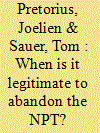

|
|
|
|
|
| Summary/Abstract |
Treaties can be denounced and withdrawn from unilaterally and collectively. We ask when it would be legitimate to abandon the NPT, a treaty that 50 years ago committed states to nuclear non-proliferation and disarmament, but still has not delivered on the latter. The end of the NPT is a taboo subject in the arms control community that sees it as the cornerstone of the nuclear order. We draw on literature on the legitimacy of and exit from international institutions. We especially explore the political substance of the discontent that the non-nuclear weapons states have expressed in and outside the NPT forum. Exiting the NPT can legitimately be used as a political tool to challenge the current status quo where five states claim a right to possess nuclear weapons based on the NPT, and to achieve a nuclear order where nuclear weapons are illegal for all.
|
|
|
|
|
|
|
|
|
|
|
|
|
|
|
|
| 8 |
ID:
185997
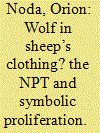

|
|
|
|
|
| Summary/Abstract |
I argue that the Treaty on the Non-Proliferation of Nuclear Weapons (NPT) not only fails to address non-quantitative forms of nuclear proliferation, but also acts as a proliferator of the symbolic values of nuclear weapons. Drawing from Semiotics scholarship, I identify two symbolic roles played by the NPT: as a symbol in itself and as a symbolic proliferator. To support my argument, I employ document and critical discourse analyses, examining the text of the treaty as well as statements from selected nuclear weapon states (NWS) and non-nuclear-weapon states (NNWS) at the 2015 NPT Review Conference (RevCon). This article is structured in two sections: Firstly, I put forward an analytical framework focused on symbolism, exploring the symbolic role of nuclear weapons. Secondly, I turn my attention to the NPT, examining its role and success in the past 50 years employing the symbolic analytical framework.
|
|
|
|
|
|
|
|
|
|
|
|
|
|
|
|
|
|
|
|
|